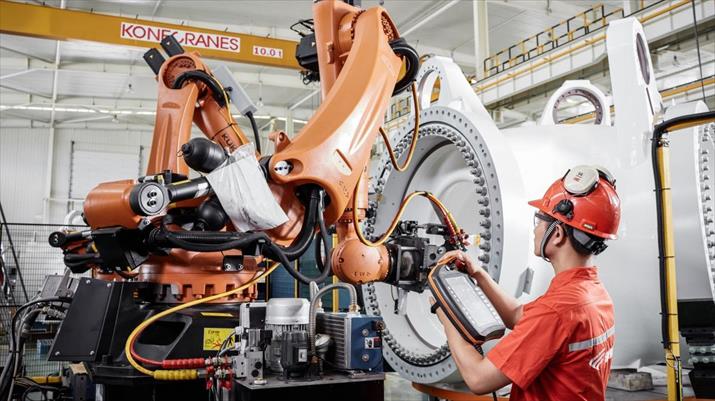| Opinion |
| S&P Underestimates China's Ability in Debt Control | |
| U.S. financial service agency S&P lowered China's sovereign credit rating from AA- to A+ on September 21, citing economic and financial risks from China's fast credit growth | |
|
|
 A technician works on an intelligent assembly line for wind turbines at Xinjiang Goldwind Sci & Tech Co. Ltd.’s plant in Hami, northwest China’s Xinjiang Uygur Autonomous Region (XINHUA)
U.S. financial service agency S&P lowered China's sovereign credit rating from AA- to A+ on September 21, citing economic and financial risks from China's fast credit growth. Tom Orlik, Bloomberg's chief Asia economist, told Xinhua News Agency that the move by S&P is likely to have little impact on investor sentiment. Khoon Goh, head of Asia Research at Australia and New Zealand Banking Group Ltd., said that there shouldn't be much impact judging from the market reaction following the Moody's downgrade a few months back. The markets were generally undisturbed by rating agency Moody's move to lower China's credit rating in May. Since Moody's decision, the Shanghai Composite Index has maintained bullish momentum, breaking above a ceiling of 3,300 points at the end of August. The Chinese yuan has also regained strength, soaring to a one-year high against the U.S. dollar in August. Experts believe that China's debt risks are manageable, given the nation's fiscal firepower, minimal foreign debt and abundant foreign reserves. Brad Setser, senior fellow at the Council on Foreign Relations, a U.S. non-profit think tank, said it is important to recognize that China's external balance sheet remains strong. China's $3 trillion in foreign reserves easily covers all of the external borrowing of China's government, banks and firms, Setser told Xinhua, adding that the total government debt is modest for an economy that saves as much as China. In past years, China has adopted a range of measures to manage debt risks, including building an early warning mechanism and a debt supervision system, and completing local government bond swaps. The latest regulatory upgrades include the introduction of a new committee on financial stability and development, announced during the two-day National Financial Work Conference in July. The conference showed Chinese leaders' commitment to the deleveraging agenda, which is definitely a positive development, Orlik said. Rather than adopting large-scale stimulus, China has been intensifying efforts to shift the engine of economic growth toward consumption, services and innovation. Analysts said such structural reforms could help reduce the nation's debt risks systematically in the long run. Paul Sheard, executive vice president and chief economist of S&P Global, recently told Xinhua that China's credit-fueled infrastructure and residential housing investment in the past decade led to a build-up of debt and credit in the economy, which is why economic reforms are critical. Sheard said it's important that institutional and market-enhancing reforms that create the right incentives for capital to be allocated efficiently continue to be implemented. Reforms should also continue to further the necessary rebalancing of the economy from excessive reliance on investment to household consumption as the key driver of economic growth and rising living standards. China's economy expanded 6.9 percent in the first half of this year, with consumption, services and new, innovation-driven economic sectors taking up larger roles. According to data from the National Bureau of Statistics, consumer expenditure contributed 63.4 percent to GDP growth in the first half and the services industry accounted for 54.1 percent of the GDP, 14 percentage points higher than the manufacturing industry. In July, the International Monetary Fund (IMF) revised upward its growth forecasts for China this year and in 2018 to 6.7 percent and 6.4 percent respectively. The IMF said the updates reflected a solid first quarter for China's economy, underpinned partially by supply-side reforms. This is an edited excerpt of an article originally published by Xinhua News Agency Copyedited by Chris Surtees Comments to yushujun@bjreview.com |
|
||||||||||||||||||||||||||||
|